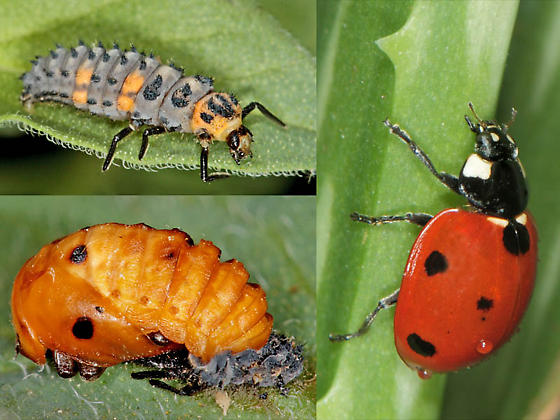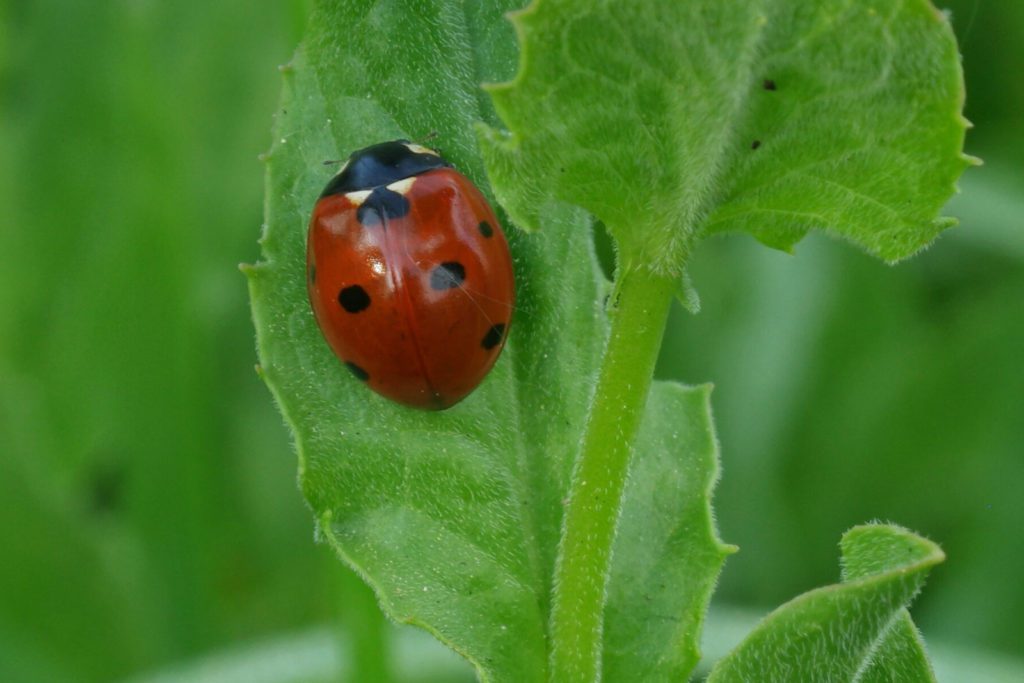Seven-spotted ladybug (Coccinella septempunctata) is one of the most famous and beloved beetles in the world. Its bright red body with seven black dots is not only an adornment of nature, but also an effective means of scaring away predators.
This little bug plays a key role in regulating pest populations, especially aphids, which makes it a valuable ally of farmers and gardeners.
In this article, we will look at biological characteristics, habitat, behavior, nutrition, life cycle, natural enemies and interesting facts about the seven-spotted ladybug.

Scientific classification
🔬 Classification of the seven-spotted ladybug:
✔ The Kingdom: Animals (Animalia)
✔ Type: Arthropods (Arthropoda)
✔ Class: Insects (Insecta)
✔ Row: Pteridopteridae (Coleoptera)
✔ Family: Ladybug (Coccinellidae)
✔ Gender: The sun (Ladybug)
✔ View: Coccinella septempunctata
📌 Interesting!
The seven-spotted ladybug is one of the most numerous and widespread species of ladybugs in the world.
Appearance and dimensions
💠 Main Features:
• Body length: 5.5–8 mm.
• Form: oval, convex.
• Color scheme: red or orange with 7 black dots.
• Head and legs: black.
• Quotes: with three joints that allow them to move easily through plants.
📌 Interesting!
The number of dots in different types of ladybugs can vary – from two to twenty-four!
Habitat and distribution
🌍 Where does the seven-spotted ladybug live?
• Europe, Asia, Africa, North America.
• Meadows, fields, forests, gardens, vegetable gardens, steppes, parks.
• It tolerates various climatic conditions well, except for very cold regions.
📌 Interesting!
Because of its benefits for agriculture, ladybugs artificially settled in the USA, Australia and other countries.
Life cycle of the seven-spotted ladybug
The life cycle of a ladybug takes place four stages:
1️⃣ Egg
• Deposited on the underside of leaves in groups of 10-50 pieces.
• Color – yellow or orange.
• Development period – 3–7 days.
2️⃣ Larva
• Looks like a tiny dragon: oblong, gray-black with yellow spots.
• Actively eats aphids – up to 100 individuals per day!
• Development continues 10-15 days.
3️⃣ Pupa
• Fixed on leaves or stems.
• It has an orange-black color.
• Duration of the stage – 5–10 days.
4️⃣ Imago (adult beetle)
• Lives from 2 to 12 months depending on the conditions.
• In autumn it falls into diapause (hibernation) under the bark of trees, in the soil or under leaves.
📌 Interesting!
Ladybug larvae often eat eggs of other insects, including even your own kind!

Nutrition and benefits in agriculture
🍽 What does the seven-spotted ladybug eat?
• Aphids (main diet).
• Scale insects, mites, small caterpillars.
• Pollen and nectar from flowers during periods of food shortage.
🌿 Why is the sun useful?
• Destroys aphidsthat harm crops.
• One beetle can eat up to 5000 aphids!
* Used in biological plant protection.
📌 Interesting!
Farmers sometimes deliberately release ladybugs into greenhouses to control pests.
Natural enemies and defenses
⚠ Main predators:
• Birds (tits, sparrows, starlings).
• Spiders (caught in spider webs).
• Frogs, lizards, ants, praying mantises.
🛡 Defense mechanisms:
• Bright colors scares away predators.
• Discharge of bitter yellow liquid (reflex bloodletting).
• Freezing in place – imitation of death.
📌 Interesting!
The yellow liquid that the sun secretes when in danger, has an unpleasant odor and is toxic to predators.

Interesting facts about the seven-spotted ladybug
🔹 Why "sun"?
• The folk name comes from bright color, similar to the sun.
🔹 Does it really bring good luck?
• In many cultures, it is believed that if a sun lands on your hand – this is a good sign.
🔹 Where do ladybugs winter?
• They gather in groups and hide under tree bark, stones, in the soil, in the cracks of houses.
🔹 Ladybugs can fly long distances!
• They rise to a height of up to 1100 meters and can fly hundreds of kilometers in search of food.
Conclusion
Seven-spotted ladybug (Coccinella septempunctata) – not just a pretty beetle, but a true natural protector of plantsIt helps. control the aphid population, saving the crop without the use of chemicals.
🌿 If you see the sun in the garden, know that you have a natural ally!